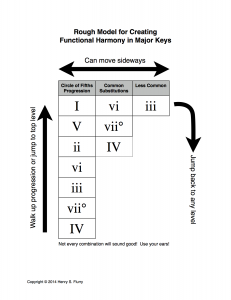
I have been experimenting with ways to give my students a more thorough understanding of functional harmony. The deeper the student’s understanding of harmony , the easier it is to learn and memorize music. Even something as simple as knowing that a V chord usually moves to I can help a student remember what harmony follows, identify new tonal areas, and understand phrase structure.
My newest experiment involves using dice to have students construct viable harmonic motion and then play it on the piano. So far, I’ve just started playing with the concept with my students who have a more advanced understanding of harmony, but I’m excited enough about the possibilities with all my students to write about this now.
In its simplest setup, I use standard dice where each number represents a harmonic chord within the major scale. 1 pip = the I chord, 2 pips = the ii chord, etc. Unfortunately, this leaves out the vii° chord, but I will discuss below my future plans to handle that! With my older students who understand roman numeral analysis of music, I am exercising their understanding of functional harmony by having them generate chord progressions from a random roll of 8 dice. The rules I play by are thus:
- Roll 8 dice.
- Create a functional chord progression by using whatever chords are given by the dice roll and following “standard practice.”
- Avoid repeating chords in this harmonic progression. (This prevents the student from resorting to a limited repertoire of chord progressions.)
- If possible, try to end with a strong cadence.
- Play the chord progression on the piano in the given key.
Notice that I put “standard practice” in quotes. We all know that there is no “standard practice,” so I resort to using a flow chart for harmonic motion slightly modified from one I was given in high school by a Dr. Bert Braud (any other New Orleans Center for Creative Arts alumnae out there?). This chart works fairly well for root position chord progressions, as long as standard voice leading rules are followed.
For my example, in preparing this post, I rolled 8 dice once — no re-rolls allowed! — and attempted to create a chord progression that followed this chart. I lucked out, as I had a couple of V and I chords in the roll. Frequently, that does not happen! I chose to arrange the dice into this progression:
ii V iii IV ii V I iii
I then realized it with this common set of keyboard voicing rules:
- The right hand plays 3 notes and is always in closed position
- The left hand always plays the root of the chord
- Chords retain common tones when moving to the next chord
- Avoid parallel octaves and fifths — typically only a risk in this scenario when there are no common tones between the chords.
I would expect a student to be able to realize at the piano, without paper and pencil, something like this:
Working with a student is interactive. I correct voice leading when necessary (e.g., if there are no common tones, move the hands in opposite direction), or make suggestions that might help improve the voice leading (e.g., try to move the bass line by step when possible). And of course there is no single “solution” to this puzzle, so for the intellectually curious student, it is worth exploring other options and discussing them. For instance, the progression below also fulfills the rules of my chart for the previous dice roll:
ii V iii IV ii III V I
It is not the one that I initially chose for the exercise I did for this blog, but I find it more pleasing. (Why? I suspect it is because of the mini-sequence in the middle. Mental note: teach the student to look for sequence possibilities.) I see a lot of potential in creating effective exercises for the developing student.
- A single die can be used to train the young student to find chords within the scale.
- 2 or more dice can be used to train common tone voice leading for the right hand.
- Multiple dice can be used to train identifying and playing a sequence of scale degrees.
I’m also thinking about group class games that might utilize harmony dice. Perhaps something like Yahtzee? Or harmony Scrabble? And I’m compiling a list of concepts to explore with my more advanced students:
- Can these dice be used to help students create more harmonically diverse compositions?
- Can I incorporate melody into this? What about having a set of scale degrees and a roll of the dice and seeing what melody and harmony a student can put together?
- How about inversions? Voice leading rules will get a little more complicated, and we start to enter the more complicated role of figured bass realization.
- What about sequences, parallel 6 chords, or other common progressions that don’t follow the chart?
- And what about that vii° chord? Or the Neapolitans, Augmented 6th, and secondary dominant chords?
Using standard dice to explore harmonic progressions is proving to be an excellent way to reinforce harmony concepts with my students. I am imagining future possibilities in teaching and exercising music theory. And, I think it is time to go beyond these six chords and make my own harmony game pieces. Even as I type this, I’m awaiting arrival of my Amazon orders of Blank White Dice and Blank Scrabble Tiles
. I’m sure I’ll be writing about my adventures in this realm later on.


